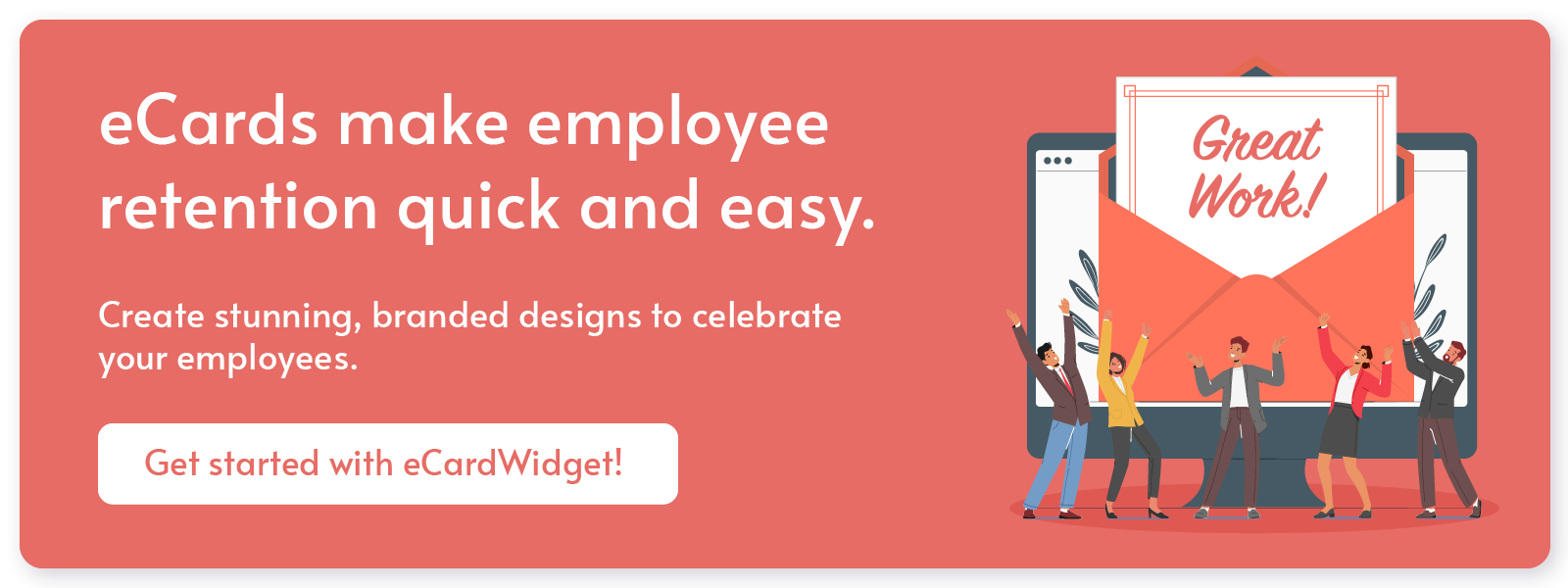- What is employee engagement?
- Why is employee engagement important?
- How do you measure employee engagement?
- How do you know if your employees are engaged?
- Top 10+ ideas for engaging your employees

What is employee engagement?
Employee engagement is a measure of how committed and invested employees are in their employers, workplaces, and jobs. Engagement is also a scale with highly engaged employees at one end, unengaged employees in the middle, and disengaged employees at the other end. To increase employee engagement, many businesses implement formal employee engagement strategies. These are frameworks for cultivating a positive work culture, increasing employee satisfaction, and boosting productivity. Creating these strategies often involves gathering feedback through surveys, offering additional perks, and using engagement software tools.Why is employee engagement important?
Your success hinges on your employees’ work, and employees are more likely to put in increased effort and stick with your business long-term if they are engaged. More specifically, the main benefits of having a highly engaged team fall into three categories:
- Retention: Retaining employees is easy when your team feels supported, valued, and able to grow in their roles. These employees are likely to stay with your business long-term, providing increased value as they use their accumulated knowledge and skills to do great work and help new team members get up to speed.
- Productivity: When employees are passionate about their jobs, they’re more enthusiastic about their work and likely to go the extra mile to create outstanding results. Along with performing their current tasks to the best of their ability, these employees will offer creative solutions for improving current work processes.
- Positivity: Employees who are positive about their work are more likely to encourage others, be productive problem-solvers, and speak highly of your business outside of work hours. This can help you build a positive word-of-mouth reputation among customers and job seekers alike.
How do you measure employee engagement?
How you measure engagement depends on your organization’s unique purpose, practices, and environment. Employee engagement software can help you both facilitate and measure the impact of your new initiatives. A few options for measuring engagement include:- Survey: The simplest way to get feedback on employee satisfaction is by asking your employees directly. Regularly survey them to find out how they feel about different aspects of their jobs, such as workload, compensation, and office environment.
- Advocacy: If your employees recommend or voluntarily advocate for your organization, it’s likely they believe in your work and are proud to represent your organization. This might be reflected in job referrals, service recommendations, and social media activity.
- Involvement: Consider which employees actively participate in events and activities outside of the regular work schedule. Employees who are happy at your organization are more likely to be involved.
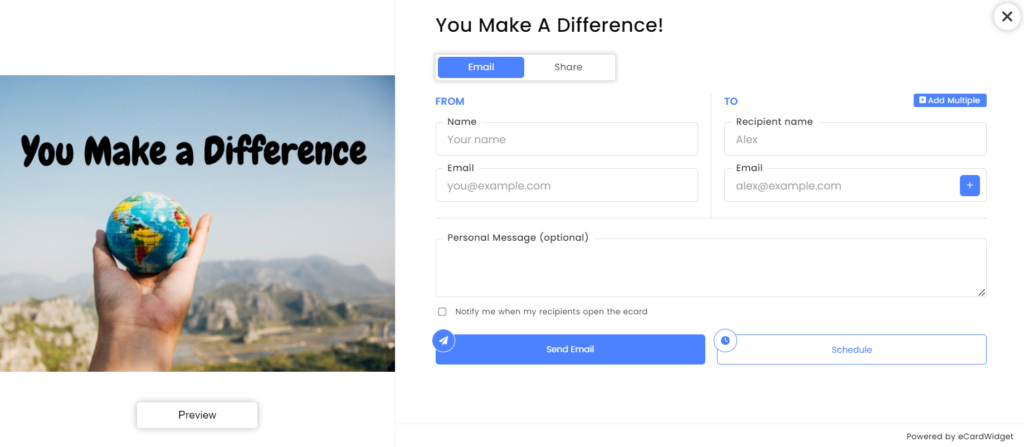
How do you know if your employees are engaged?
Surveys are the most straightforward way to determine if employees are engaged, but you should be able to assess whether you have an engaged team by noticing if you are receiving any of the benefits we discussed previously. If you see the following signs around the office, chances are that your engagement strategy is working:- Positive attitude: Engaged employees are happy to do their work and approach situations with a positive attitude. They’re enthusiastic about their roles and support your organization’s goals.
- Surpassing expectations: Employees who feel fulfilled in their work situation regularly go above and beyond. They’ll search for ways to bring genuine value to the organization and take personal ownership of their projects.
- Successful teamwork: Engaged employees are more likely to want to connect with and work alongside their colleagues. Your team will not only collaborate on work tasks but also create a positive workplace culture.
Top 10+ ideas for engaging your employees
While there is no one-size-fits-all approach to employee engagement, there are a few tested strategies that many organizations, including both businesses and nonprofits, have found successful. To help your organization, we’ll explore a few top solutions we’ve seen succeed.1. Show appreciation.
When employees are regularly recognized for their hard work, they’re more likely to keep it up. While appreciation can take many forms, one ideal method for employee engagement programs is eCards. eCards are digital greeting cards that can be sent via email, text message, or social media. With an eCard creation and delivery platform, your business can design custom eCards and send them out to employees to celebrate their accomplishments. There are two ways eCards can engage your employees:
- Top-down recognition involves a member of leadership showing appreciation for an employee. If a manager notices a member of their team going the extra mile, they can thank them immediately for a job well done via an eCard.
- Peer-to-peer recognition occurs when colleagues show appreciation for one another. While less formal than top-down recognition, peer-to-peer recognition allows more team members to be appreciated and show their appreciation, which can build a stronger sense of community.
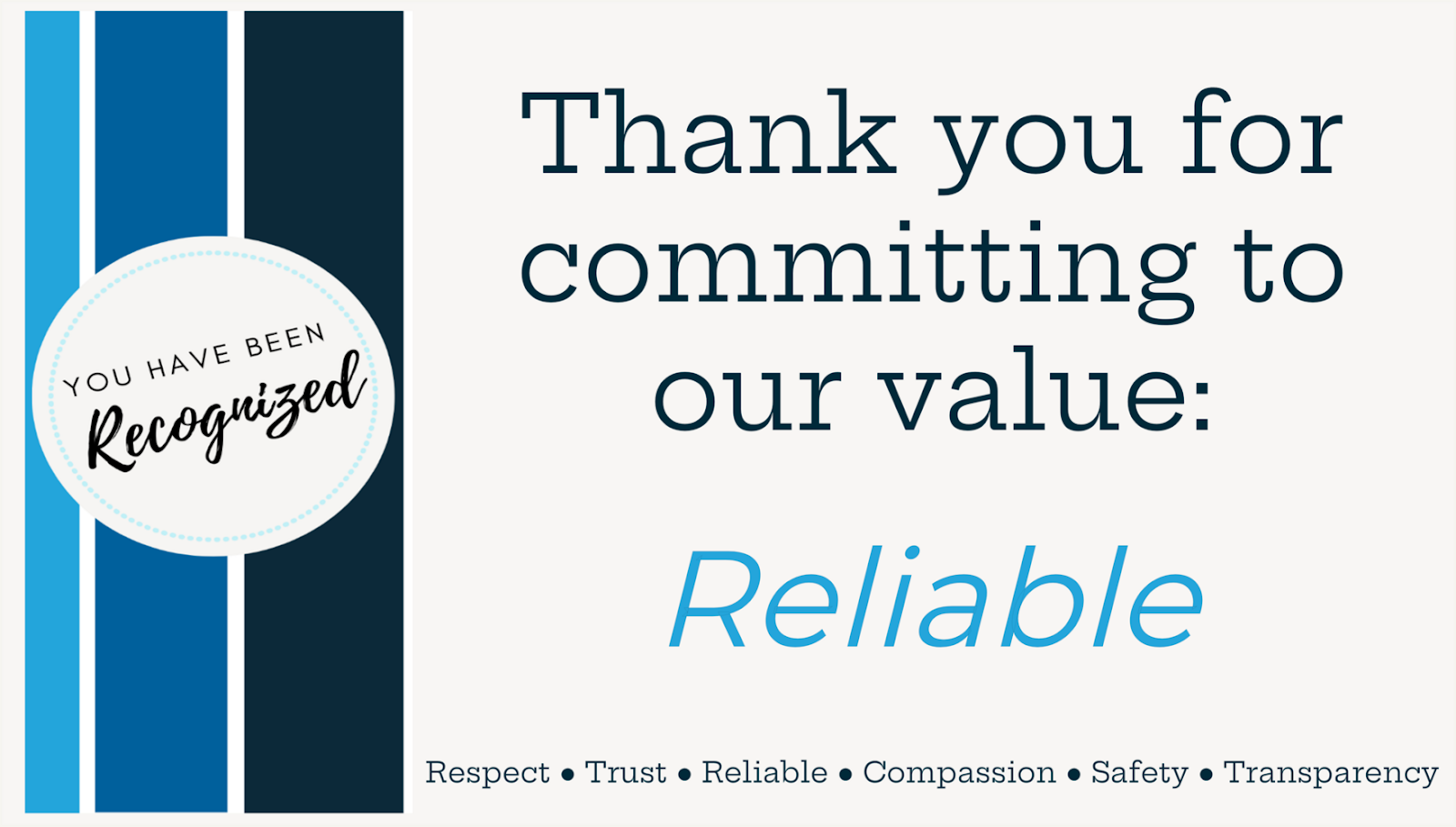
When To Show Employee Appreciation
Timing means everything when it comes to employee appreciation. Showing recognition at just the right moment can amplify its impact. Prompt appreciation not only boosts morale but also encourages continued excellence. Being mindful of when you show appreciation can make all the difference in developing a supportive work environment. To make recognition part of your organization’s culture, show appreciation during these specific times:- Everyday Accomplishments and Milestones: Shout out employees each time they receive positive client feedback, complete a project, or reach a milestone like a work anniversary. You might send them a fun eCard detailing their accomplishments or shout them out in a team meeting.
- Birthdays: Wish employees a happy birthday to show you care! Using our automated birthday eCard feature means you’ll never forget an employee’s birthday. Upload each employee’s birthday to their contact profile within our platform. Then, create a few birthday-themed eCards and craft meaningful messages. When you create multiple messages or birthday eCards, the platform will cycle through different combinations to offer each employee a unique birthday wish.
- Holidays: Holidays like Thanksgiving or New Year’s Day provide the perfect opportunity to show gratitude for your employees and look back on their accomplishments from the past year. Send them a special gift or holiday eCard explaining your appreciation.
- Employee Appreciation Day: This lesser-known holiday occurs on the first Friday of March each year, providing the perfect opportunity to throw a company party or post about your wonderful employees on social media. For a personalized approach, send individual, thoughtful eCards to celebrate Employee Appreciation Day.

2. Connect employees’ work to your company goals.
Employees want to know their individual contributions matter, and if they are unsure how their day-to-day tasks impact your organization, they may become disengaged. Show your team how each individual member matters by helping employees see the bigger picture at your company. Plus, checking in keeps everyone on the same page and moving toward the same objectives. This can help employees make accurate decisions if a task is ever unclear and prevent projects from going off the rails. The easiest way to connect employees’ work to your organization’s goals is to write out the purpose behind new tasks when you assign them. For example, when you create a new job posting, you likely add a few sentences explaining what the purpose of the role is and how it fits into your company.3. Plan work culture events.
Employees may want to make connections with their coworkers but feel they don’t have the time to do so during the normal work day. Provide them with opportunities to get to know one another in a more casual context with work culture events. For example, you might host events for:- Birthdays: Post a calendar of all your employees’ birthdays in an easily accessible place. Then, allow your employees to buy cakes and streamers to celebrate. As an employer, make a special effort to attend these celebrations and wish your employees a happy birthday.
- Holidays: Make your annual holiday parties a little more fun by celebrating smaller holidays throughout the year. For example, order a few pies for your employees on Pi day (March 14th.)
- Company anniversaries: Celebrate important dates for your company, like the day your organization was founded. You can also celebrate employees’ anniversaries, such as a certain number of years working for the company, and hand out awards to commemorate their accomplishments.
- Hobby how-tos: Your employees have unique hobbies that fill their time outside of the office. Help your team get to know each other better by hosting events about their hobbies. For example, if you learn that an employee is skilled in knitting, purchase yarn and knitting needles for an after-work gathering where that employee leads everyone in making a simple knitting pattern.
4. Create a two-way feedback system.
To help your employees feel understood, ask for their feedback regularly so that they always have an opportunity to be heard. Consider asking for feedback with a survey or checking in via email on a regular basis. Focus the intent of each survey by asking questions about a specific aspect of your organization. For example, you might survey employees about their experiences with a new task management system or how they feel a specific project went. For your first surveys, get a general sense of how your team views your workplace by asking questions like:- What is something you think the company should start doing?
- What is a missed opportunity for revenue for the company?
- How do you feel about our company’s values?
- What part of the company’s mission statement do you feel you’ve served recently?
- What could the company do to improve office culture?
- How do you feel you’re excelling in your role? How do you feel you’re challenged in your role?
5. Launch a workplace giving program.
Engage your employees by giving them a chance to make a difference through their work. Corporate social responsibility (CSR) programs are opportunities for your organization to give back to the community and create social good. Many of these programs will be managed by leadership or specific philanthropic teams, but other employees can participate, too. This can increase engagement by allowing them to personally make an impact. A few types of workplace giving programs you might involve employees in include:- Matching gifts: Incentivize giving by matching employee’s donations to their favorite charities. Have employees report their donation amounts to you, review their matching gift applications, and then double or even triple their donations by matching their gift amount.
- Volunteer grants: Support employees’ volunteer efforts by donating monetary gifts in response to the hours contribute to nonprofits. For example, you might offer to donate $100 for every 10 hours volunteered.
- Volunteer days: Get your team involved in giving back by arranging a corporate volunteer day. On this day, your team will go out to volunteer together at a local nonprofit. Remember to arrange your volunteer day and what activities your employees will be doing with the nonprofit far in advance to allow the organization to plan tasks your entire time can do together.
6. Provide growth and development opportunities.
If your employees are excited about their work, they’ll likely want to grow in their roles. Provide opportunities for professional growth on any scale. For example, you might offer:- Tickets to conferences directly related to their jobs or the company’s industry
- Training programs or certificates to help them learn more about their specific roles
- Stipends to pay for courses related to their work
7. Create an employee experience program.
To engage your employees, you need to understand their day-to-day experiences. With an employee experience program, you can create a systemized framework for collecting employee feedback, identifying pain points, and creating a better work environment. Employee experience consists of all interactions employees have with your business. An employee experience program organizes those interactions to find trends and identify recurring problems. While the details of your program will vary, generally employee experience programs follow this model: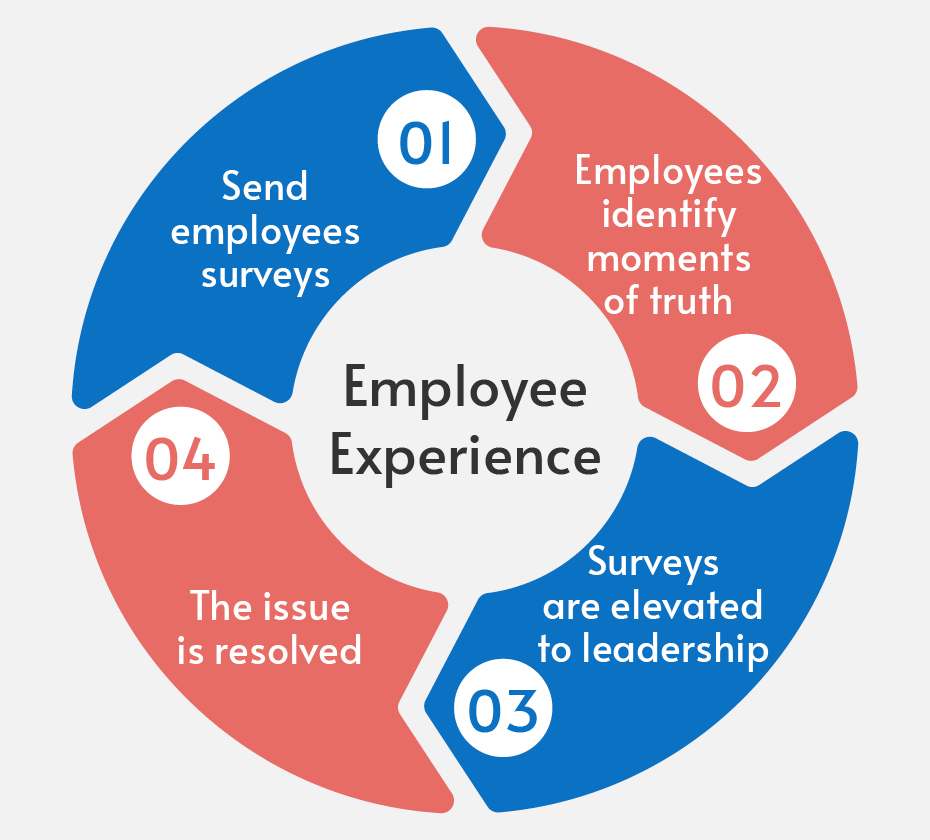
- Employees are surveyed about their experiences.
- Employees highlight pain points in their day-to-day work.
- Surveys are elevated to appropriate members of leadership, such as employees’ managers.
- The members of leadership assess issues raised and either resolve them or pledge to investigate further to find underlying causes.
- The employee is notified that a solution has been implemented or is being considered.
8. Offer flexible working conditions.
Hybrid work is the new normal with nine out of ten employees preferring a hybrid work environment. If your organization can go hybrid, consider what you would need to do to give employees flexible working conditions. For instance, a few ways you can cultivate a cohesive company culture in a hybrid environment include: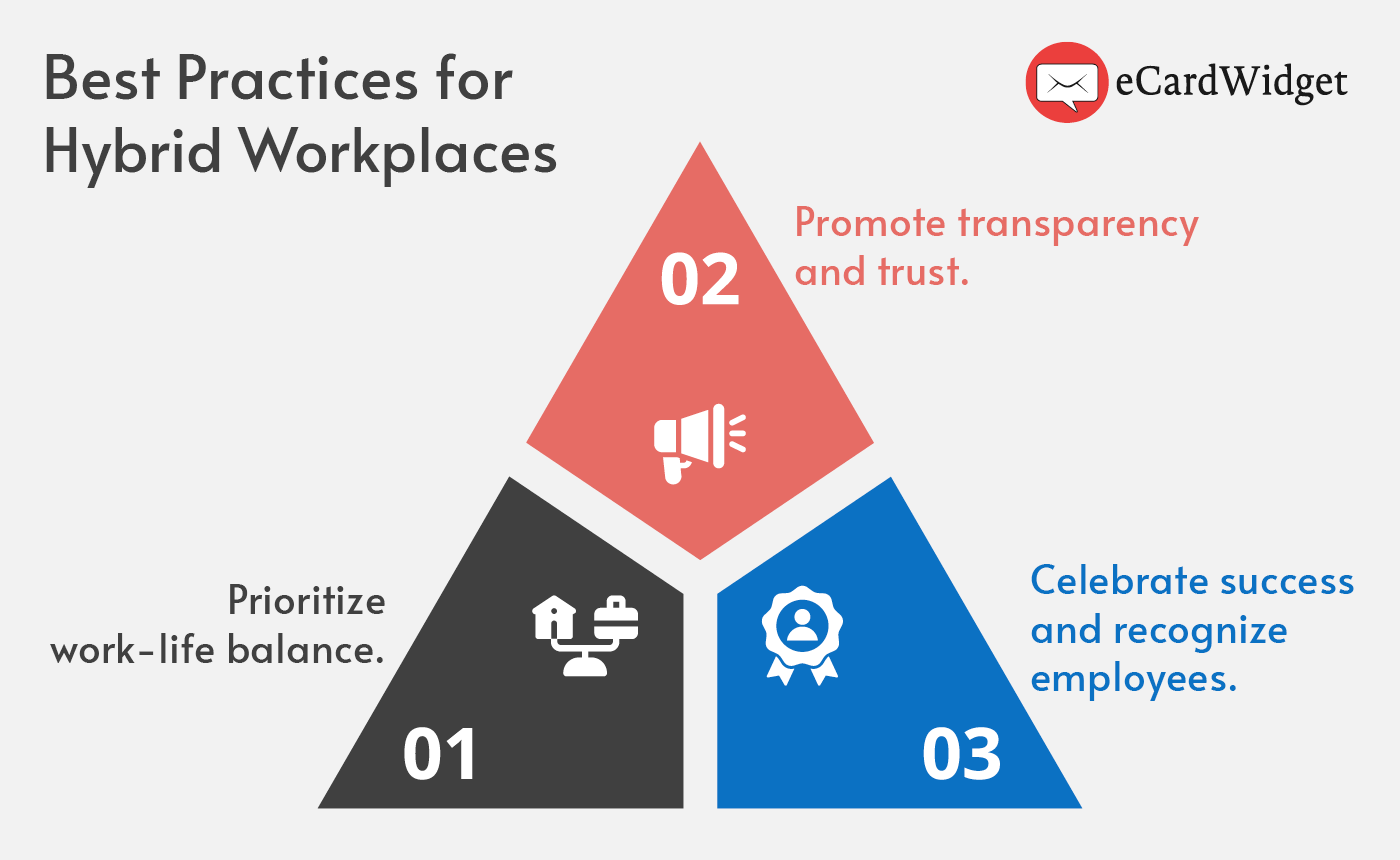
- Encouraging employees to establish designated workspaces in their homes and create a healthy work-life balance
- Setting clear communication expectations to promote trust and transparency
- Using virtual appreciation strategies, like eCards
9. Hire for fit.
Building an engaged team starts during the hiring process. This doesn’t mean exclusively hiring individuals who share the same background but rather assembling a team that will work well together and be productive. Consider what values, communication styles, and work preferences will make for a cohesive team that thrives in your specific industry. Then, add questions to your job interviews that will help reveal whether a candidate is a good fit for your team. For instance, you might ask questions that show if a candidate is:- Teamwork-focused or independent
- Likely to ask for help or likely to problem solve on their own first
- Competitive or collaborative
- Creative and risk-taking or focused on sticking to guidelines
- Social and friendly or interested in putting their head down and working
10. Highlight success.
Show off employee successes by highlighting their work-related accomplishments. This is an opportunity to appreciate high-performing employees and show the rest of your team how you reward hard work and success at your organization. A few ways you can highlight success include:- Send eCards: As mentioned earlier, eCards are a meaningful and convenient way to show your appreciation for employees. In your eCard message, write down specifically what you’re recognizing the employee for so they feel appreciated and know what behavior to replicate in the future. For more tips on using eCards for employee recognition, check out this video from our team:
- Show public recognition: Some of your employees may appreciate a bit of public attention. For these high performers, consider shouting out their accomplishments during an all-hands meeting or making a social media post praising how they’ve contributed to your organization.
- Hand out awards: A physical award you can hand to an employee can go a long way toward making them feel appreciated. This might be a trophy, certificate, plaque, or other tangible object employees can take home with them. For instance, you might create an “employee of the month” certificate and publicly hand it out on the first day of each month.
11. Provide fair and competitive compensation.
While your employees have many reasons for choosing to work for your business, ultimately, they are there to earn fair compensation for their work. If employees feel they are not earning what their work is worth, they may become disengaged or seek other career opportunities. When it comes to communicating your compensation policies, transparency is key. Employees appreciate knowing how much they will earn, when they will be paid, and why their salary and benefits are set at their current amounts. If there is a disruption, such as your payroll system experiencing technical issues, get ahead of the situation and let employees know what is happening and why. This will allow them to set their expectations accurately and prevent misunderstandings. In performance management meetings, have proper documentation for employees that explains their current compensation, including benefits. This will help guide salary negotiations and provide a foundation for future conversations. Be ready to make additional notes and adjustments based on employees’ feedback, such as if they feel they have taken on increased responsibilities or their role has significantly changed. Additionally, keep an eye on your competitors’ compensation practices. If a business similar to yours offers better benefits and salary ranges, previously engaged employees may consider changing employers.Final Thoughts on Employee Engagement
To truly engage your employees, you’ll have to find opportunities for your company to stand out in creative ways. Look for meaningful methods to make your employees feel appreciated for their work and excited about their jobs. For more ideas about employee engagement and creating a positive work environment, check out the additional resources below:- How to Motivate Employees: 12 Easy Ways to Uplift Workers. If you’re struggling to keep employees engaged, this ultimate guide shares creative ways to motivate your staff members and improve company culture.
- Marketing eCard Software: Custom Digital Greeting Cards. eCards add a bit of creativity to employee engagement. Explore our solution to get an idea of how it’ll work at your organization.
- Employee Coaching: Complete Overview and How-To Guide. A big part of employee engagement is providing them with the skills to succeed. Dive into employee coaching with this guide from RealHR Solutions.
